How and Why to Create an Alternate Family Tree
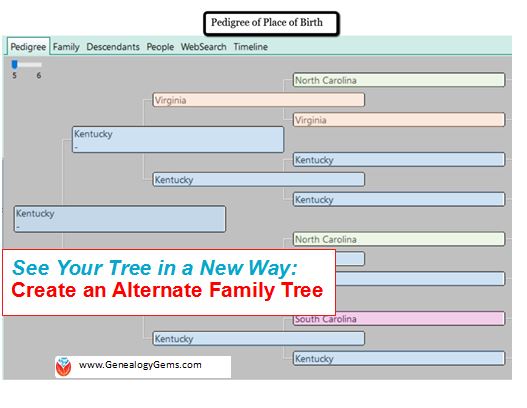 Use an “alternate family tree” to emphasize unique or interesting patterns in your family history, such as eye or hair color, birthplace, age at death, or adoption. Here’s how to do it–and WHY.
Use an “alternate family tree” to emphasize unique or interesting patterns in your family history, such as eye or hair color, birthplace, age at death, or adoption. Here’s how to do it–and WHY.
Alternate family trees are popping up all over social media and genealogy blogs. Have you seen them? Some trees emphasize the age at death, cause of death, or birthplace for each individual.
There can be tremendous value to creating trees like these. Recognizing patterns can help tear down brick walls. Imagine a pedigree chart with birth places instead of names. It’s a new way to see migration patterns. I also love the a-ha moments I have! For example, the time I realized my hair and eye coloring likely came from my maternal great-grandmother who I have a special connection with.
I can share these quick “did you know” revelations with my relatives on social media (totally shareable images!) or at family reunions. Images are often more powerful than words because they are easy to glance over. Your family won’t be able to resist taking a look, and most importantly, sharing your tree images with other family members. Shared images can generate new information when shared with the right relative. Hey, here’s an idea: you could even blow up your alternate family tree to poster size for the next family reunion!
Take a look at these examples of my own alternate family trees for age at death (left) and birthplace (right).
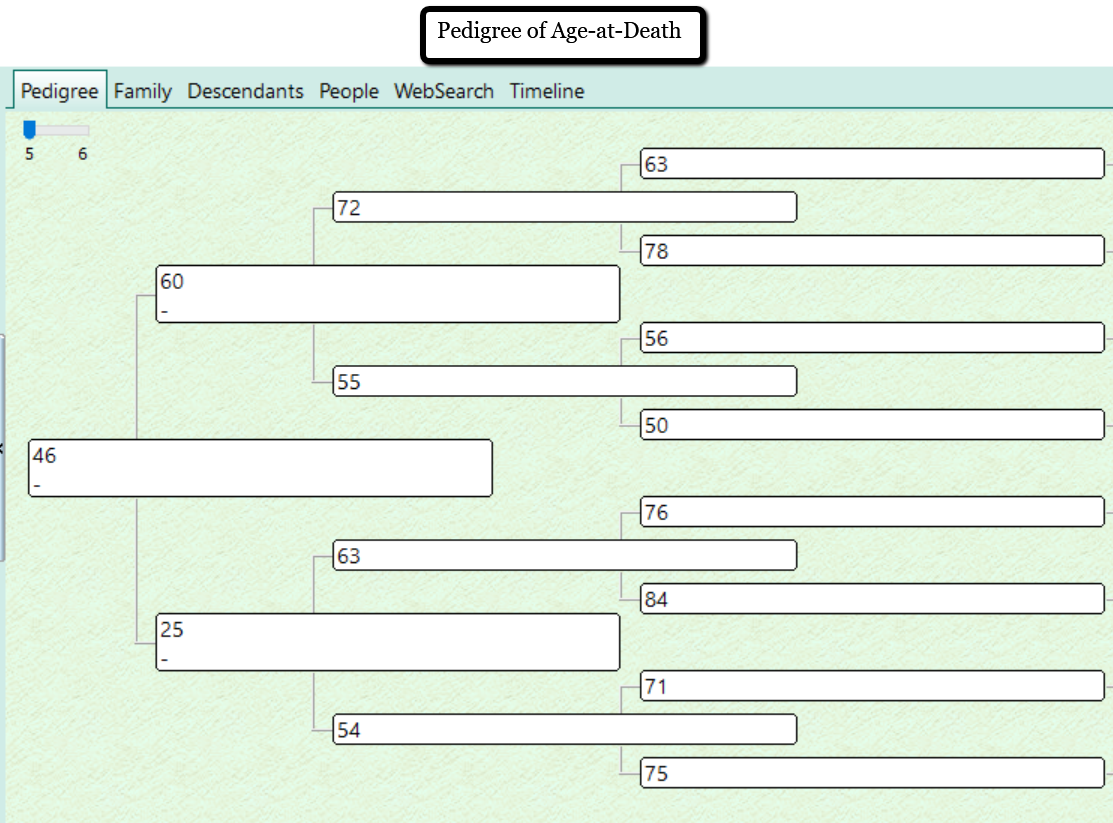
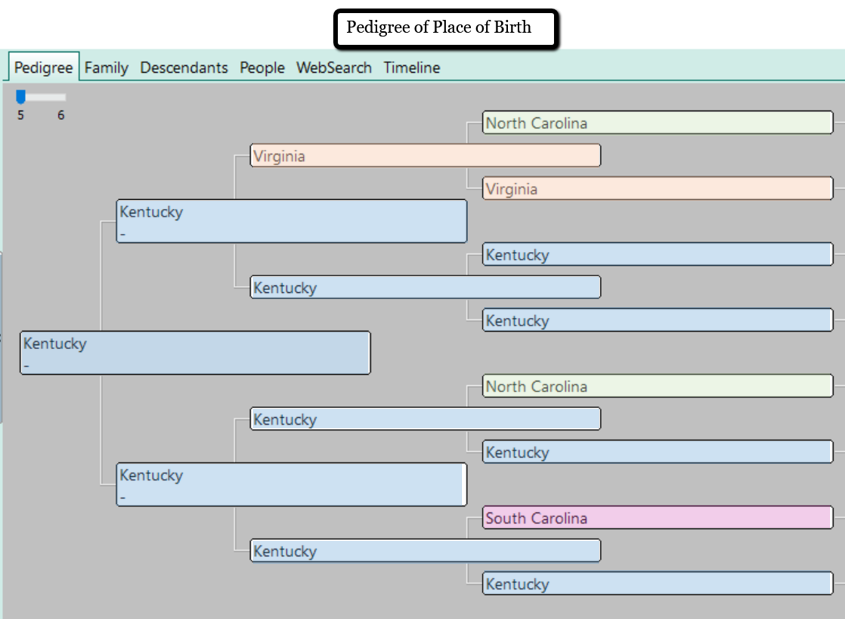
Other alternate family trees may focus on occupations, schooling, or color of eyes or hair.
I was inspired to create an alternate family tree that had significance to my own immediate family. We have a lot of adoption in our family tree. My three children are adopted, my husband is adopted, and several of my great-grandparents were raised by other family members. This is a unique perspective. Blood lines are important, but even more important are those people who influenced my family the most as caregivers.
I created a pedigree that indicates who, if anyone, the father and mother figures were. Take a look:
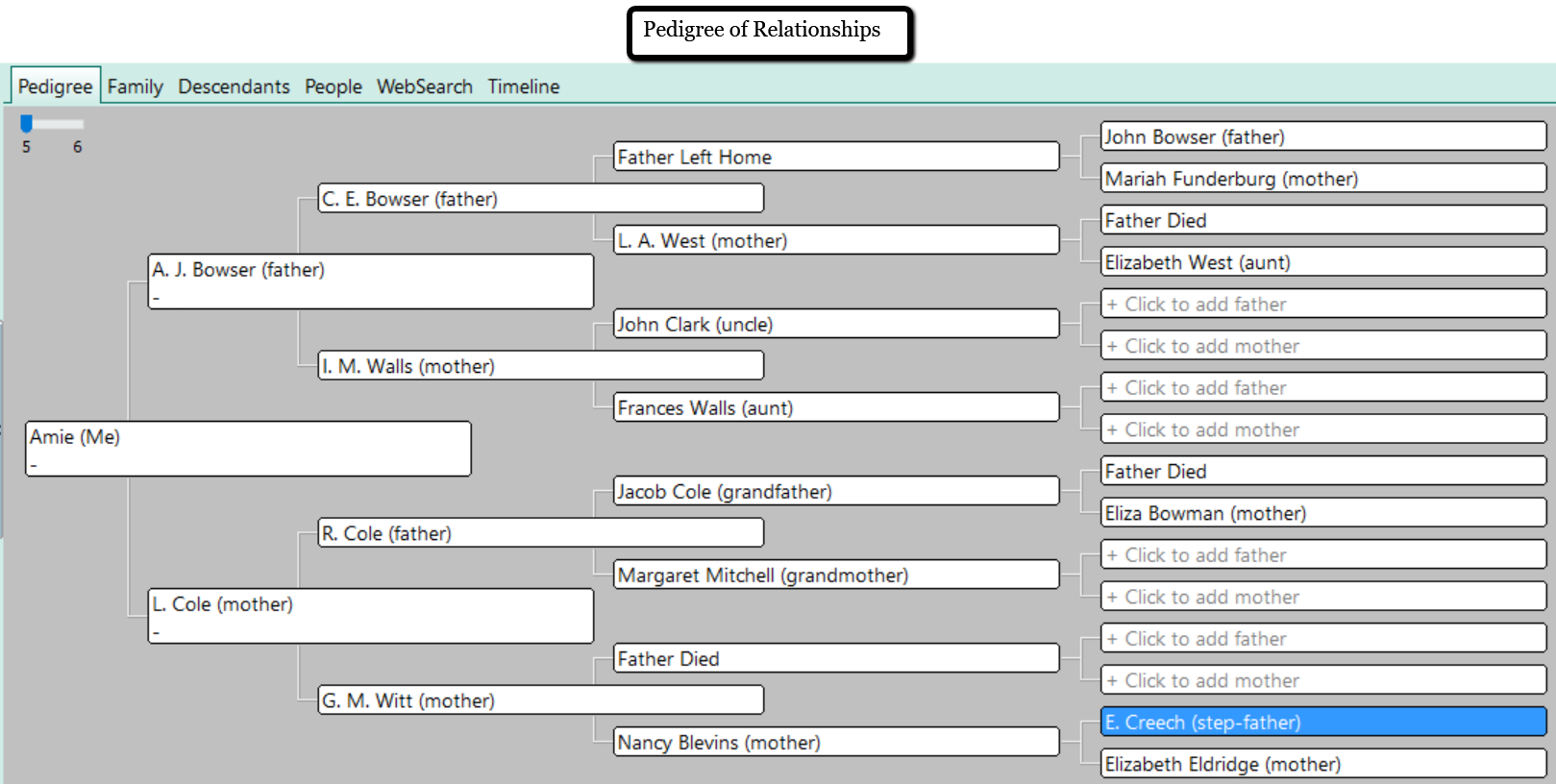
Did you notice that every set of my great-grandparents had one or more parent die or abandon them? I was shocked to see this significant ancestral dynamic. I had never considered the likely effect of such a family tree. It was fascinating!
How to Create an Alternate Family Tree
The easiest way to create an alternate family tree is to use a genealogy software program. I use RootsMagic. RootsMagic is a genealogy software program for PC and Mac computers. (Note: To use RootsMagic on your Mac computer, you will need to use the MacBridge add-on.) You can purchase the full version of RootsMagic for $29.95 or you can use the RootsMagic Essentials for free!
There are two ways to make an alternate family tree using RootsMagic. You can start from scratch or use the wall chart report.
Starting from Scratch
To start a new pedigree:
- click the “blank sheet of paper” icon at the top left. Name your tree with a title that will indicate its purpose. (Example: Age-at-Death Tree)
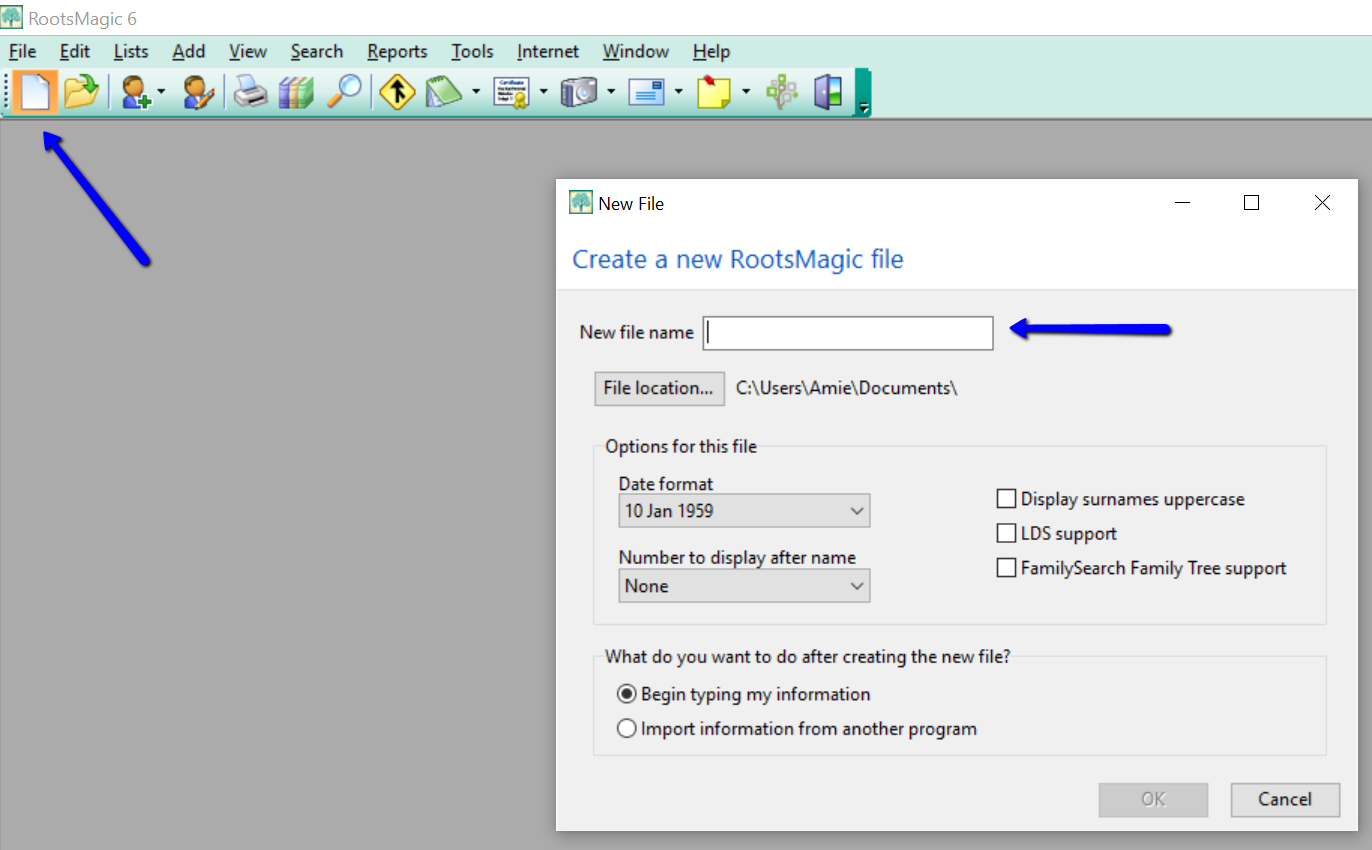
- Instead of using the names of your ancestors, use whatever alternate pieces of information you wish in the name fields.
- Now, you simply click “Reports” across the top and choose “Pedigree.” You can generate the report and print out your new alternate tree.
Using an Existing Tree
If you already have your tree on RootsMagic, you can use the Wall Chart feature to create trees with unique data.
As an example, if I wanted to create an occupation family tree, I would first need to enter that data for each person by clicking on the individual and then “Add a Fact.” From the drop-down list, choose “occupation.” Type in the occupation in the description field at the right and click “Save.”
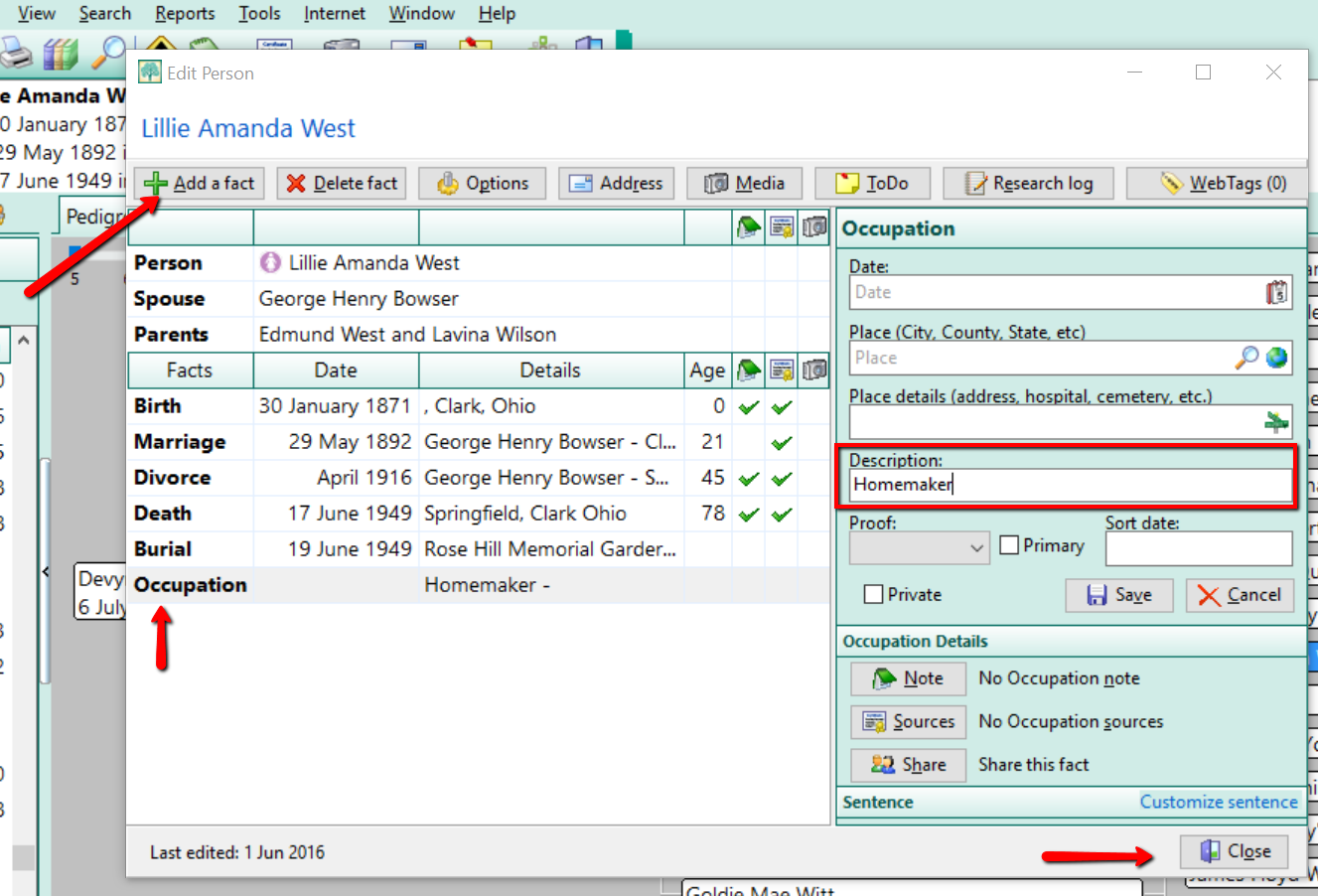
Add the occupation to each individual and when you are ready to print your alternate family tree, simply take the following steps in the image below.
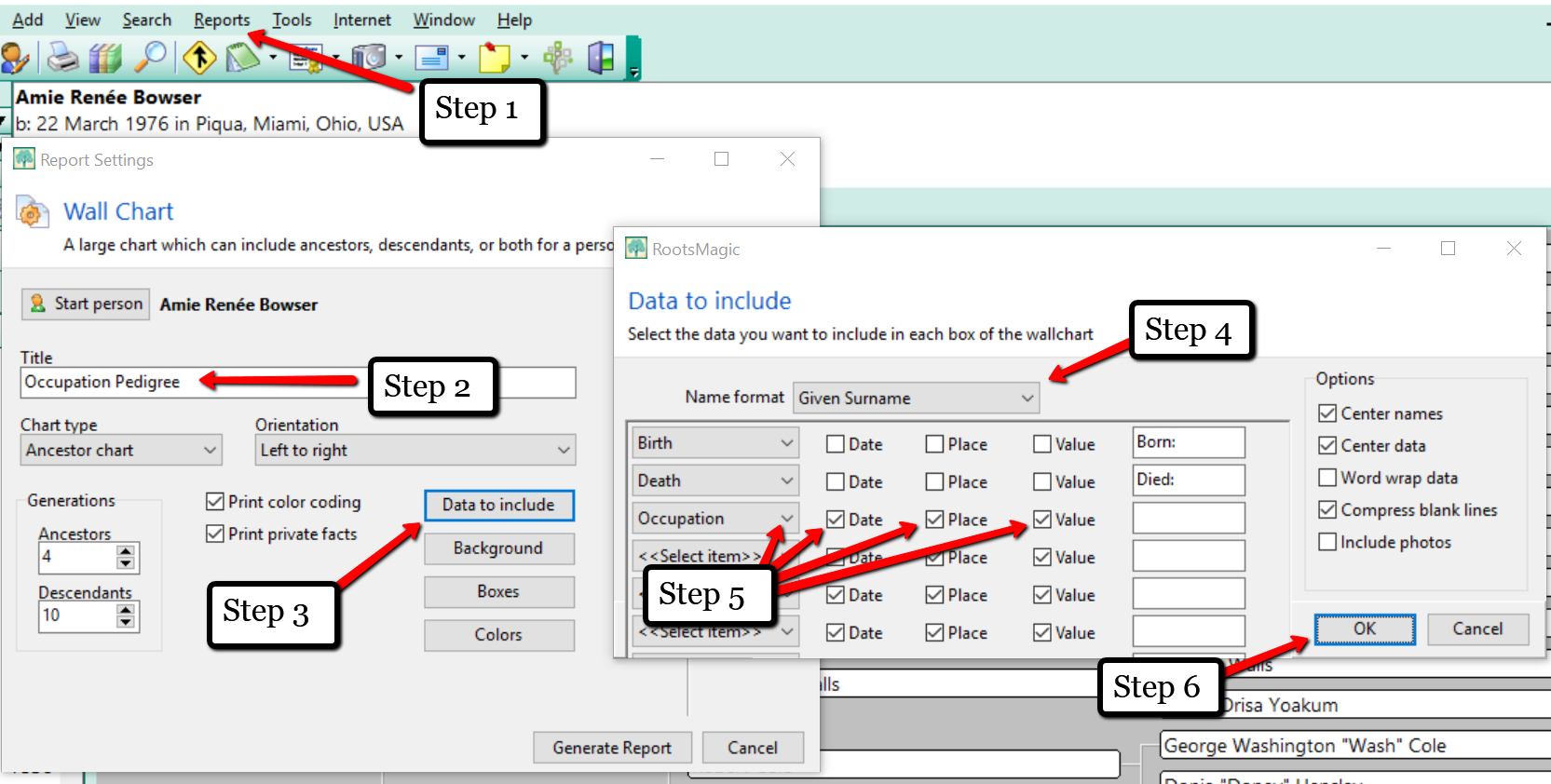
After taking these six steps, it is time to “Generate Report.” You will be taken to a new screen where you will see your creation.
Once you have completed your alternate tree, it’s a great idea to print it and lay it out in front of you. You might ask yourself, “What does this information tell me?” The interpretation of the data will be unique for everyone. Maybe your “Cause of Death Tree” will make you think, “Oh no! I should really be watching my heart health!”
I hope that you will take the opportunity to create an alternate family tree or two today. Genealogy Gems Premium website members who like this idea will also want to listen to Genealogy Gems Podcast #136, due out later this month. In that episode, Your DNA Guide Diahan Southard goes in depth on the value of gathering family health history.
How does this view of your family tree make you feel?
We love to hear from you so leave your feelings or comments below,
and please feel free to share your alternate family tree on our Facebook page!
More Family Tree and RootsMagic Gems
Family Tree Etiquette: Online Private v. Public Trees
 Recently we heard from Julie who listens to the podcast overseas. She is weighing the pros and cons of having her online family tree be private or public. Public trees can be searched and viewed by the general public and/or other members of that particular website. Private trees are just that. They are generally only searchable and viewable by individuals who have been invited to see them by the owner.
Recently we heard from Julie who listens to the podcast overseas. She is weighing the pros and cons of having her online family tree be private or public. Public trees can be searched and viewed by the general public and/or other members of that particular website. Private trees are just that. They are generally only searchable and viewable by individuals who have been invited to see them by the owner.
Julie shares some great observations about what it’s like to work with other tree owners and how it feels when information is freely taken from her–but there is no sharing in return.
On working with other people’s public trees:
“If it wasn’t for [other people’s] trees being public–even the ones with sketchy information–I would not have made contact with distant cousins or made many of the discoveries I have. Some of the dodgy information has helped me to improve my search and analytical skills and I always contact the owner if I have found something that doesn’t ring true (hopefully diplomatically!). Most of the time the tree owners are grateful and we then exchange more information.
When information is copied from my tree I will often contact the person to see how we are related and to see if we might be able to collaborate some more. (I don’t post everything I have on my online databases.) If I get no response it does leave me feeling uncomfortable (especially when it is photos) about having posted the info and it being taken without any communication. I do also contact tree owners when I copy photos or documents, even if it is just to say thank you. Maybe it is because photos are that much more personal.”
On working with private tree owners:
“I find it even more frustrating when someone with a private tree copies things from my public tree without making any contact. This is then exacerbated if I contact them and they don’t respond. Maybe I’m being unreasonable – or maybe I’m missing something. It comes across to me that they are willing to take but not that willing to share. One person I did contact who responded very kindly shared some information with me but was very blunt about the fact they did not want to see any of the information they provided on the internet, yet they had happily taken some of the documents/photo’s I had posted. I found that interesting.”
So…private or public?
“I am now feeling unsure about which is the best way to go as I can see pros and cons about both. In the meantime I have stopped adding media to my online tree, and I’m considering removing some of what I have posted and instead include a note saying if you want the document/photo please contact me. However, I am not convinced about this as I love it when I find photos/documents on other trees.”
I do wish for a more communal genealogy world, in which information is shared freely and all branches of a family tree intertwine themselves in love. Of course that’s not how things are. But I feel like every person who “puts things out there” brings us closer to that ideal.
That said, I admit I’ve copied photos and documents from other people’s trees in the past without contacting them. I didn’t mean to be rude. It just didn’t occur to me to contact them, especially if they clearly weren’t closely related and I had no immediate questions about their sources. But you’re right. Photos feel more personal. In the future I hope I will always remember to send a “thank you” message whenever I snag someone’s images for my tree.
I appreciate Julie’s compromise: she keeps a public presence but encourages others to be respectful and communicative by telling them to contact her for images. You’d likely have to look closely at her tree to find those messages from her, which will reward the most intrepid researchers. Beginning or more casual researchers might miss her invitation and therefore an opportunity to collaborate.
For everyone, whether to post a private v. public tree comes down to our priorities. Do we most want to meet distant relatives? Collaborate with other branches of the family to learn the most possible about our shared past? If so, public trees are the way to go. If personal or family privacy is paramount (especially if your tree holds family secrets that aren’t ready to share), or the research is still very tentative, make it a private tree.
You may even split things up: have public trees when you’re reaching out to others and private ones when you’re not. Lisa says if she had to do it all over again, she would not upload her entire tree but just the “trunk,” or her direct-line ancestors. (Lisa always keeps her master tree on her home computer, not in online genealogy databases over which she has no control.)
Whether your own trees are public or private, Julie’s thoughts are a good reminder about using our best manners when communicating with other tree owners. Here at Genealogy Gems, we do believe in the value of collaborating on your genealogy. In fact, we ran a series of posts on how to collaborate. Check out the first one here! And we have a brand new free video on using the free program Evernote to share your sources.

